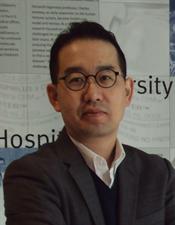Sep 7 2015
Much like birds fly in flocks to conserve energy, dolphins swim in pods to mate and find food, and colonies of ants create complex nests to protect their queens, immune cells engage in coordinated behavior to wipe out viruses like the flu.
 Minsoo Kim, Ph.D.
Minsoo Kim, Ph.D.
That’s according to a new study published in the journal Science by researchers at the University of Rochester School of Medicine and Dentistry.
The findings reveal, for the first time, how immune cells work together to get to their final destination – the site of an injury or infection. The body is expansive and a virus or bacteria can take hold in any number of locations: the lungs, the throat, the skin, the stomach or the ear, just to name a few. How do immune cells, specifically the ones that are responsible for killing foreign invaders, know where to go?
A team of scientists discovered that cells called neutrophils – the “first responders” of the immune system – are the key. They arrive at the site of injury within an hour of infection and leave a chemical “trail” of sorts behind them. Killer immune cells called T cells use this trail to find the site of injury and subsequently destroy the invader. (In the video, killer T cells (red) follow a chemical “trail” (green) left by neutrophils to find the site of an infection.)
In fact, when scientists removed neutrophils (or their trails) from the equation, T cells didn’t find the site of injury as quickly or easily; they were more dispersed, fewer made it to the site of injury, and the ones that did were less effective at fighting the infection.
“Immune cells team up and share information to get their job done, much like many types of animals take part in collective behaviors to benefit the group as a whole,” said Minsoo Kim, Ph.D., lead study author and associate professor of Microbiology and Immunology at the School’s David H. Smith Center for Vaccine Biology and Immunology.
“Understanding how immune cells collaborate to arrive at the site of an infection will lead to new ways to control and improve the body’s response to all types of illnesses,” added David J. Topham, Ph.D., co-author and the Marie Curran Wilson and Joseph Chamberlain Wilson Professor of Microbiology and Immunology.
For example, in people with autoimmune disorders like multiple sclerosis and lupus, the immune system mistakenly attacks and destroys healthy body tissue. If scientists understood how to disrupt or stop immune cells’ movement to healthy tissue, they may be able to improve the quality of life of people living with these devastating diseases.
Similarly, recognizing how to boost the number of immune cells that travel to fight an infection could help scientists design better vaccines for viruses like the flu.
The research is part of a $9 million National Institutes of Health Research Program Project Grant that was awarded to scientists in the School of Medicine and Dentistry in 2014. Led by principal investigator Deborah J. Fowell, Ph.D., dean’s professor of Microbiology and Immunology, the goal of the five-year grant is to use cutting-edge imaging techniques to view the immune system while it is fighting infection and disease.
Immune Cells Work Together to Fight Infections
Kim’s team used an extremely powerful technology called a multiphoton microscope to watch how various types of immune cells traveled to the trachea or windpipe of mice infected with the flu. The flu typically starts in the airways, and watching immune cells move in whole tissues in real time – as opposed to watching immune cells in a lab dish – provides a much more accurate picture of how the immune systems functions.
The multiphoton microscope is part of the University’s Multiphoton Core Facility, which contains state-of-the-art systems enabling in vivo (Latin for “in the living”) imaging and analysis. The team at the School of Medicine and Dentistry is one of just a few immunology research groups in the world using this technology. Scientists from around the world will travel to the University in November for the 1st Annual Immune Imaging Symposium.